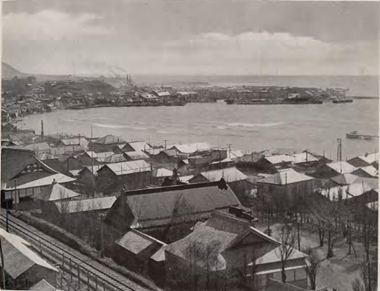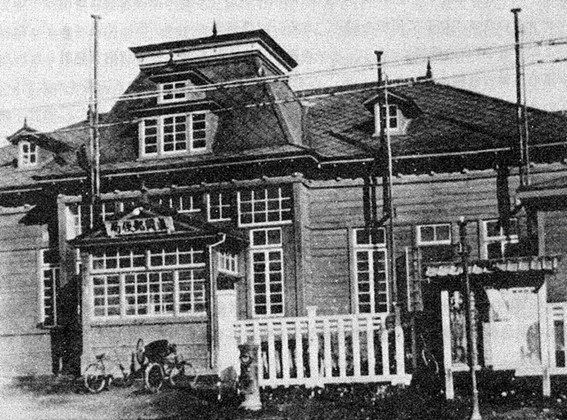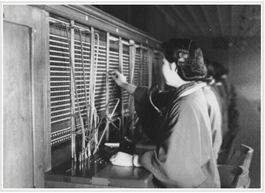By Kai Nakabayashi
Introduction
Following the naval invasion of Maoka (modern-day Kholmsk) on 20 August 1945 in a move to split the Southern Sakhalin in two parts, Soviet soldiers were soon patrolling the street in front of the city’s Post Office. On the same day, the female switchboard operators made their final transmissions to the neighboring stations to report that they intended to commit suicide. This topic of suicide, should the enemy come, was one of the casual conversations which the female operators conversed in daily and in the end, the casual conversations turned into reality when the Soviets began its liberation of Karafuto (Southern Sakhalin) on 11 August 1945. Their assault continued even after Japan’s official declaration of surrender on August 15 with an amphibious invasion of the southern parts of Karafuto aimed to take its major regional city of Maoka on August 20. The reason behind the operators’ decision to remain at their post is highly debated, but one thing can be certain: the army communication units that were supposed to replace them should war beset on Karafuto never came, and nine out of twelve operators would take their own lives rather than allow themselves to surrender to the Soviet troops. Why did they stay? Why did they have to die? Why are their stories unknown by most Japanese? These questions constitute the major factors of the following content.
The Revision of Women’s Role during the Second World War
As war progressed, Japanese women were faced with contradicting social expectations from that of a traditional household wife to the total national mobilization requirements that the Empire relied on to keep its military industry fully operational. From the onset of the Second Sino-Japanese War in 1937 to the final days of war in 1945, the clash between Japan’s patriarchal hierarchy and the reality of labor shortages continued, which forced Japanese women to live under a harsh dilemma: being considered a hikokumin (traitor) should they not participate in the war effort, or work under the knowledge that they were considered as tsukaisute (disposable).[1]
The Expected Battle of the Japanese Mainland – The Northern Frontline
Though the existence of the Soviet-Japanese Neutrality Pact signed on 13 April 1941 allowed the Japanese military planners to focus their efforts on the war against the United States, and the threat of Soviet invasions greatly diminished when the Soviets did not attack the Japanese borders after the Nazi invasion of the Soviet Union on June 22 of the same year, the reality of the Soviet-Japanese border on the island of Sakhalin (Karafuto) lead to an overwhelmingly tense atmosphere for the Japanese border guards that forced its garrison commander to issue strict orders not to open fire under any circumstances.[2]
While the threat of a Soviet invasion was virtually imminent, the Karafuto garrison command began to prepare for a possible American invasion of the island through the La Pérouse Strait (Sōya Strait) after receiving reports of the complete decimation of the Japanese forces in the Aleutian Islands that was part of Alaska.[3] This operation was shifted to a more realistic threat when a large number of Soviet troops began to assemble along the Soviet side of the border on 20 July 1945,[4] and the Karafuto garrison consisting of the 88th Division (Dai-hachijūhachi Shidan), detachment of the Military Police (Kenpeitai)[5], reserve units comprised of local police units, and civilian volunteers that included students from the local middle school.[6]

Figure 1. Subprefectures of Karafuto Prefecture, 2004.
A map of Karafuto with the four prefectures (the city of Maoka marked on the prefecture colored in green) in 1945.

Figure 2. Vicinity of Maoka Port. Karafuto Prefectural Government. 樺太写真帖 (Maoka, Karafuto: Karafuto Prefectural Government, 1936), p. 33. National Diet Library Digital Collection.
The city of Maoka was one of the major industrial port cities in Karafuto.
Southern Sakhalin (Karafuto) Postal Telegram Service
The Southern Karafuto under Japan can be described as a series of typical Japanese coastal settlements with its major industries consisting of fishery, wood, and pulp.[7] Its industrial capabilities had led to the establishment of Japanese civil administrations consisting of its own police and fire department, and the creation of a major road that spanned from the Japanese-Soviet border to the southernmost city of Maoka. One of the most vital civil services that existed on the island was the post office, where information and communication were collected and distributed through its telephone switchboard office operated by female telephone switchboard operators.[8]

Figure 3. Maoka Post Office, 1945. Asahi Newspaper Digital.
Maoka Post Office was part of a robust network of telegram stations in Karafuto used for both civilian and military purposes.
Duty as a Combatant or as an Operator
As stated in the previous section, reserve units consisting of schoolchildren and Japanese citizens designated as civilians were eventually pressed into military service. So what about the female workers who remained at their station in Maoka? Unlike the Himeyuri student nurse volunteers who fell alongside the soldiers at the Okinawan frontline, they were telephone switchboard operators and by no means designated as combat operatives. Yet, they remained at the Maoka Post Office and in the end, nine took their own lives as the Soviets began advancing into their building. Their final telephone exchanges with the neighboring stations of Toyohara and Tomarioru[9] showed evidence of the operators’ fears of being raped by the Soviet soldiers that were recorded as visibly patrolling the streets outside the post office.[10]
The debate of whether the operators were following a direct order or acting upon their own free will is still unclear due to the unpreparedness for civilian assets against the Soviet invasions. It is important to note that the emergency evacuation orders were only given four days after the Soviets breached the Soviet-Japanese border[11] and due to its hastiness, the army communication units (that were supposed to take over the post office in times of combat) never came. This lead the station chief to supposedly give an “order” to the skeleton crew remaining at the post office to keep the communication lines open for military use.[12]

Figure 4. Telephone Switchboard Operator, 1939. Postal Museum Japan.
A commonly-used telephone switchboard and equipment for the operators used by Japanese Post Office before and during the Second World War.
Silenced Voices
Post-war Japan brought a wave of revisionism and a rise of communist sympathizers as the nation pushed for radical democratic changes.[13] In the process, prewar and wartime era educational textbooks were heavily censored, while Japanese military records were quickly expunged from public records in the wake of the Allied occupation of Japan. The rising threat of the Soviet Union, in both military and diplomatic terms, caused the tragic story of Southern Sakhalin to be suppressed while the Soviet government did not consider the invasion of Southern Sakhalin as an invasion at all, but a liberation to return the land to the former Russian inhabitants.[14]

Figure 5. Nine Maidens’ Monument. (Hokkaido, Japan: 100yen), 2006.
A monument dedicated to the nine operators in Hokkaido continues to silently tell the tragic story of Maoka.
[1] Havens 1975, p. 921.
[2] Fushimura 2017, p. 28.
[3] Kaneko 1972, p. 20.
[4] Fushimura 2017, p. 38.
[5] Sakamoto 2015, p. 98.
[6] Fushimura 2017, p. 39.
[7] Kaneko 1972, pp. 22-24.
[8] Wakkanai City, “‘Kunin no otome’ no monogatari”.
[9] Hokkaido Fan Magazine 2020.
[10] Kawashima 2008, p. 122.
[11] Kawashima 2003, p. 14.
[12] Kawashima 2003, p. 133.
[13] Kawashima 2008, p. 189.
[14] Slavinsky 1993, p. 81.
References
Fushimura Takeo 藤村建雄. Shirarezaru hondo kessen minami Karafuto shūsen-shi: Nihonryō minami Karafuto 17-kakan no sensō 知られざる本土決戦南樺太終戦史―日本領南樺太十七日間の戦争. Kojinsha, 2017.
Havens, Thomas. “Women and War in Japan, 1937-45.” The American Historical Review, 40:4 (1975), 913-934.
Kaneko Toshio 金子俊男. Karafuto 1945-nen natsu: Karafuto shūsen kiroku 樺太一九四五年夏―樺太終戦記録. Kodansha, 1972.
Kawashima Yasuo 川嶋康男. Kunin no otome: Isshun no natsu, “shūsen hiwa” Karafuto, Maoka yūbinkyoku denwa kōkan-te no jiketsu 九人の乙女 一瞬の夏―「終戦悲話」樺太・真岡郵便局電話交換手の自決. Kyobunsha, 2003.
Kawashima, Yasuo 川嶋康男. Eiketsu no asa: Karafuto ni chitta kunin no teishin otome 永訣の朝―樺太に散った九人の逓信乙女. Kawade Shobo Shinsha, 2008.
Sakamoto Yuichi 坂本悠一. Chiiki no naka no guntai 地域のなかの軍隊. Yoshikawa Kobunkan, 2015.
Slavinsky, Boris N. Chishima senryō: 1945-nen natsu 千島占領―一九四五年夏. Trans. Kato Yukihiro 加藤幸広. Kyodo Tsushinsha, 1993.
Tanigawa Mitsue 谷川美津枝. On’na-tachi no taiheiyō sensō: Kita no senjō Karafuto de tatakatta otome-tachi no sei to shi 女たちの太平洋戦争―北の戦場 樺太で戦った乙女たちの生と死. Kojinsha, 1995.
Hokkaido Fan Magazine. “Kita no himeyuri jiken to kunin no otome” 北のひめゆり事件と九人の乙女. 2020.02.16. Retrieved from https://hokkaidofan.com/maoka19450820/.
Wakkanai City. “‘Kunin no otome’ no monogatari”「九人の乙女」の物語 Retrieved from https://www.city.wakkanai.hokkaido.jp/kanko/gaiyo_rekishi/9ninotome.html.
Sōka Gakkai Fujin Heiwa Iinkai 創価学会婦人平和委員会. Heiwa e no negai o komete 11 Karafuto, Chishima hikiage (Hokkaidō)-hen: Fureppu no shima tōku 平和への願いをこめて11樺太・千島引揚げ(北海道)編: フレップの島遠く. Daisanbumeisha, 1984.
